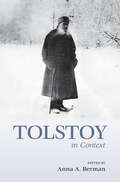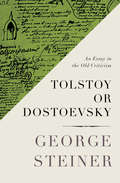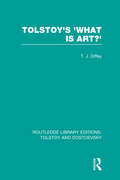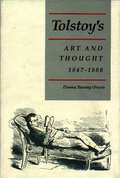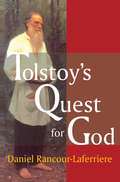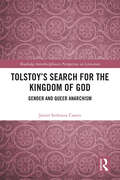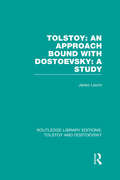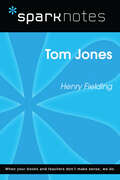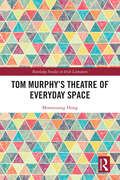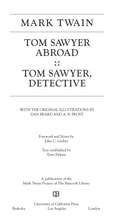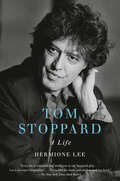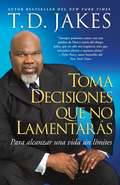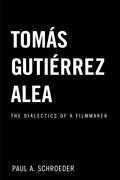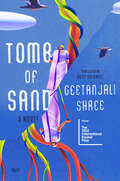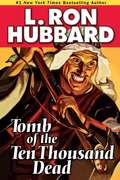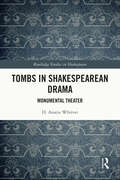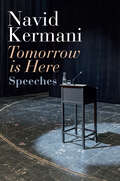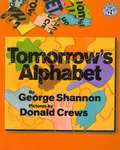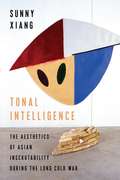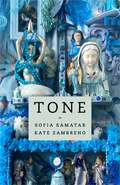- Table View
- List View
Tolstoy in Context (Literature in Context)
by Anna A. BermanLikened to a second Tsar in Russia and attaining prophet-like status around the globe, Tolstoy made an impact on literature and the arts, religion, philosophy, and politics. His novels and stories both responded to and helped to reshape the European and Russian literary traditions. His non-fiction incensed readers and drew a massive following, making Tolstoy an important religious force as well as a stubborn polemicist in many fields. Through his involvement with Gandhi and the Indian independence movement, his aid in relocating the Doukhobors to Canada, his correspondence with American abolitionists and his polemics with scientists in the periodical press, Tolstoy engaged a vast array of national and international contexts of his time in his life and thought. This volume introduces those contexts and situates Tolstoy—the man and the writer—in the rich and tumultuous period in which his intellectual and creative output came to fruition.
Tolstoy or Dostoevsky: An Essay in the Old Criticism
by George SteinerThe first book of criticism from the acclaimed author of After Babel—a &“provocative and probing&” look at Russian literature&’s most influential writers (The New York Times). &“Literary criticism,&” writes Steiner, &“should arise out of a debt of love.&” Abiding by his own rule, Tolstoy or Dostoevsky is an impassioned work, inspired by Steiner&’s conviction that the legacies of these two Russian masters loom over Western literature. By explaining how Leo Tolstoy and Fyodor Dostoevsky differ from each other, Steiner demonstrates that when taken together, their work offers the most complete portrayal of life and the tension between the thirst for knowledge on one hand and the longing for mystery on the other. An instant classic for scholars of Russian literature and casual readers alike, Tolstoy or Dostoevsky explores two powerful writers and their opposing modes of approaching the world, and the enduring legacies wrought by their works.
Tolstoy's 'What is Art?': An Essay In The Philosophy Of Art (Routledge Library Editions: Tolstoy and Dostoevsky)
by Terry DiffeyWith its demand that works of art be judged according to the their morally didactic content, Tolstoy’s reviled aesthetics has seemed to exclude from the canon far too many works widely accepted as masterpieces, including Shakespeare and Beethoven. This book, first published in 1985, argues that these are not mere oversights on the part of Tolstoy: he knew full well the consequences of his line of reasoning. The author contends that, even if we disagree with and eventually reject much of what Tolstoy concludes, his account of the nature and purpose of art is nevertheless worth consideration. Diffey’s argument by no means accepts all of ‘What is Art?’, but by suggesting that the work is best interpreted as a counterpoint to the amoral aestheticism prevalent in Russia at the time, he does much to restore it to a status deserving attention, particularly in today’s climate of extreme relativism.
Tolstoy's Art and Thought, 1847-1880
by Donna Tussing Orwin"My aim is to present Tolstoy's work as he may have understood it himself," writes Donna Orwin. Reconstructing the intellectual and psychic struggles behind the masterpieces of his early and middle age, this major study covers the period during which he wrote The Cossacks, War and Peace, and Anna Karenina. Orwin uses the tools of biography, intellectual and literary history, and textual analysis to explain how Tolstoy's tormented search for moral certainty unfolded, creating fundamental differences among the great novels of the "pre-crisis" period.Distinguished by its historical emphasis, this book demonstrates that the great novelist, who had once seen a fundamental harmony between human conscience and nature's vitality, began eventually to believe in a dangerous rift between the two: during the years discussed here, Tolstoy moved gradually from a celebration of life to instruction about its moral dimensions. Paying special attention to Tolstoy's reading of Rousseau, Goethe, Schopenhauer, and the Russian thinker N. N. Strakhov, Orwin also explores numerous other influences on his thought. In so doing, she shows how his philosophical and emotional conflicts changed form but continued unabated--until, with his religious conversion of 1880, he surrendered his long attempt to make sense of life through art alone.
Tolstoy's Quest for God
by Daniel Rancour-LaferriereThe religious dimension of Tolstoy's life is usually associated with his later years following his renunciation of art. In this volume, Daniel Rancour-Laferriere demonstrates instead that Tolstoy was preoccupied with a quest for God throughout all of his adult life. Although renowned as the author of War and Peace, Anna Karenina, The Death of Ivan Ilych, and other literary works, and for his activism on behalf of the poor and the downtrodden of Russia, Tolstoy himself was concerned primarily with achieving personal union with God.Tolstoy suffered from periodic bouts of depression which brought his creative life to a standstill, and which intensified his need to find comfort in the embrace of a personal God. At times he was in such psychic pain he wanted to die. Yet Tolstoy felt that he deserved to suffer, and he learned to welcome suffering in masochistic fashion. Rancour-Laferriere locates the psychological underpinnings of Tolstoy's suffering in a bipolar illness that led him actively to seek suffering and self-humiliation in the Russian tradition of holy foolishness. With voluntary suffering, and Jesus Christ as his model, Tolstoy advocated nonresistance to evil, and in his daily life he strove never to return evil actions or words with physical or verbal resistance. On the other hand, being bipolar, Tolstoy in some situations would drift in a manic direction, indulging in delusions of grandeur. Indeed, the aging Tolstoy occasionally went so far as to equate himself with God, as can be seen from his diaries and personal correspondence.The pantheistic world view which Tolstoy achieved at the end of his life meant that God was within himself and within all people and all things in the entire universe. By this time Tolstoy was also utilizing images of a mother to represent his God. With this essentially maternal God so conveniently available, there was nowhere Tolstoy could be without Her. For, in the end, Tolstoy's quest for God was a
Tolstoy's Search for the Kingdom of God: Gender and Queer Anarchism (Routledge Interdisciplinary Perspectives on Literature)
by Javier Sethness CastroBuilding on its predecessor, Queer Tolstoy: A Psychobiography (2023), this book uncovers queer-anarchist dimensions of the second half of Count Lev Nikolaevich Tolstoy's life (1828–1910) and of the Russian writer's later art-works. It features queer-friendly readings of Anna Karenina (1875–1877), The Gospels In Brief (1881), “The Death of Ivan Ilych” (1886), “The Kreutzer Sonata,” (1889), “Master and Man” (1895), and Resurrection (1899), among other classics. However, the argument does not overlook the gross misogyny expressed by Tolstoy in either his art or his marriage with Countess Sofia Andreevna Tolstaya. Rather, the author explores the fundamental contradictions between sexism and anti-authoritarianism while critiquing Tolstoy's self-defeating commitment to patriarchy. The text also praises the writer's late turn toward preaching Christian anarchism, as it traces aspects of Tolstoy's artistic and political resonance in the twentieth century, including pacifist plant-based communes, the Russian and Mexican Revolutions, the Bloomsbury Group, the Catholic Worker, and Soviet-era hippies.
Tolstoy's Short Fiction
by Michael KatzThis Norton Critical Edition presents twelve of Tolstoy’s best-known stories, based on the Louise and Aylmer Maude translations (except “Alyosha Gorshok”), which have been revised by the editor for enhanced comprehension and annotated for student readers. The Second Edition newly includes “A Prisoner in the Caucasus,” “Father Sergius,” and “After the Ball,” in addition to Michael Katz’s new translation of “Alyosha Gorshok.” Together these stories represent the best of the author’s short fiction before War and Peace and after Anna Karenina. <p><p> “Backgrounds and Sources” includes two Tolstoy memoirs, A History of Yesterday (1851) and The Memoirs of a Madman (1884), as well as entries―expanded in the Second Edition―from Tolstoy’s “Diary for 1855” and selected letters (1858–95) that shed light on the author’s creative process. <p> “Criticism” collects twenty-three essays by Russian and western scholars, six of which are new to this Second Edition. Interpretations focus both on Tolstoy’s language and art and on specific themes and motifs in individual stories. Contributors include John M. Kopper, Gary Saul Morson, N. G. Chernyshevsky, Mikhail Bakhtin, Harsha Ram, John Bayley, Vladimir Nabokov, Ruth Rischin, Margaret Ziolkowski, and Donald Barthelme. <p> A Chronology of Tolstoy’s life and work and an updated Selected Bibliography are also included.
Tolstoy: An Approach bound with Dostoevsky: A Study (Routledge Library Editions: Tolstoy and Dostoevsky)
by Janko LavrinThis volume contains two concise works by the innovative twentieth-century literary critic Janko Lavrin, offering accessible and thoughtful introductions to the two greatest Russian novelists. It provides a perfect point of access into the often bewildering world of Russian literature, and the troubled geniuses which created it. Tolstoy: An Approach, first published in 1944, is an attempt to interpret Tolstoy as an artist and thinker in light of the twentieth-century experience: specifically, it seeks to discern the relationship between Tolstoy the novelist and Tolstoy the religious pseudo-prophet, thereby articulating the contours of his most essential ethical and psychological insights. In Dostoevsky: A Study, published first in 1943, Lavrin suggests a wide range of valuable observations and intriguing possibilities, exploring the enigmatic and perennially fascinating Dostoevsky in terms of the inter-connections between his life, his thought, his relationships, his writing, and the socio-cultural circumstances in which he found himself.
Tolstoy: His Life and Work (Routledge Revivals)
by Derrick LeonThis book, first published in 1944, provides a comprehensive overview of the work and life of the writer and philosopher Lev Nikolayevich Tolstoy. Widely considered one of the greatest novelists of all time, this title examines some of Tolstoy’s most seminal works, including War and Peace and Anna Karenina. This book will be of interest to students of literature and philosophy.
Tom Jones (SparkNotes Literature Guide Series)
by SparkNotesTom Jones (SparkNotes Literature Guide) by Henry Fielding Making the reading experience fun! Created by Harvard students for students everywhere, SparkNotes is a new breed of study guide: smarter, better, faster. Geared to what today's students need to know, SparkNotes provides: *Chapter-by-chapter analysis *Explanations of key themes, motifs, and symbols *A review quiz and essay topicsLively and accessible, these guides are perfect for late-night studying and writing papers
Tom Murphy’s Theatre of Everyday Space (Routledge Studies in Irish Literature)
by Moonyoung HongBy the time of his death in 2018, Tom Murphy was widely recognised as one of Ireland’s most important modern playwrights. Ireland’s experience of rapid modernisation, emigration, and globalisation is vividly captured in his plays, challenging generic notions of space, place, and the nation. In particular, his drama reconfigures Irish theatre’s uneasy relationship with globalisation, with the peasant kitchen, the pub, and the bog having traditionally been exported as the quintessential Irish spaces. Focusing on one of Murphy’s central innovations—his experimentation with theatre and everyday space—the book considers the significance of Murphy’s work in modern drama more broadly. The idea of “home” has preoccupied modern playwrights since the naturalist dramas of Henrik Ibsen and Anton Chekhov, leading theatre scholars to focus on the everyday space of the home to the exclusion of other everyday spaces. Murphy’s works, by contrast, offer a new politics of the “alterior,” engaging with a diverse range of other spaces such as dancehalls, grocery shops, pubs, hotels, offices, churches, gasworks, and airports. His drama presents a “global sense of the local,” an emotional map of the shifting geographies of everyday life. By applying new theoretical perspectives and showcasing new archival materials inaccessible to previous scholars, the book revisits Murphy as an international playwright— a cartographer of our modern-day “global village.”
Tom Robbins: A Critical Companion
by Catherine E. Hoyser Lorena Laura StookeyArticles on Another Roadside Attraction; Even Cowgirls Get the Blues; Still Life with Woodpecker; Jitterbug Perfume; Skinny Legs and All; and Half Asleep in Frog Pajamas.
Tom Sawyer Abroad / Tom Sawyer, Detective
by Mark Twain John C. Gerber Dan Beard Terry FirkinsThese unjustly neglected works, among the most enjoyable of Mark Twain's novels, follow Tom, Huck, and Jim as they travel across the Atlantic in a balloon, then down the Mississippi to help solve a mysterious crime. Both with the original illustrations by Dan Beard and A.B. Frost. "Do you reckon Tom Sawyer was satisfied after all them adventures? No, he wasn't. It only just pisoned him for more." So Huck declares at the start of these once-celebrated but now little-known sequels to his own adventures. Tom, Huck, and Jim set sail to Africa in a futuristic air balloon, where they survive encounters with lions, robbers, and fleas and see some of the world's greatest wonders.
Tom Stoppard: A Life
by Hermione LeeOne of our most brilliant biographers takes on one of our greatest living playwrights, drawing on a wealth of new materials and on many conversations with himOne of our most brilliant biographers takes on one of our greatest living playwrights, drawing on a wealth of new materials and on many conversations with himTom Stoppard is a towering and beloved literary figure. Known for his dizzying narrative inventiveness and intense attention to language, he deftly deploys art, science, history, politics, and philosophy in works that span a remarkable spectrum of literary genres: theater, radio, film, TV, journalism, and fiction. His most acclaimed creations--Rosencrantz and Guildenstern are Dead, The Real Thing, Arcadia, The Coast of Utopia, Shakespeare in Love--remain as fresh and moving as when they entranced their first audiences.Born in Czechoslovakia, Stoppard escaped the Nazis with his mother and spent his early years in Singapore and India before arriving in England at age eight. Skipping university, he embarked on a brilliant career, becoming close friends over the years with an astonishing array of writers, actors, directors, musicians, and political figures, from Peter O'Toole, Harold Pinter, and Stephen Spielberg to Mick Jagger and Václav Havel. Having long described himself as a "bounced Czech," Stoppard only learned late in life of his mother's Jewish family and of the relatives he lost to the Holocaust.Lee's absorbing biography seamlessly weaves Stoppard's life and work together into a vivid, insightful, and always riveting portrait of a remarkable man.
Toma decisiones que no lamentars (Making Grt Decisions; Span)
by T. D. JakesEste libro servirÁ de guÍa a quienes quieran tomar la decisiÓn correcta--ya sea en el matrimonio, los estudios o la compra de una casa--escrito por el renombrado pastor, autor y hombre de negocios, T.D.Jakes.Para sus lectores, T.D. Jakes no es tan solo un predicador: tambiÉn les proporciona las herramientas prÁcticas y psicolÓgicas que necesitan para impulsar la fe en su vidas. Claro, realista y espiritualmente vibrante, Antes de decidir es uno de esos libros singulares que logran cambiar vidas. "Recuerda", escribe T.D. Jakes, "tu maÑana es el producto de las decisiones que tomas hoy". seguir para lograr una relación amorosa, un matrimonio y una familia firmes y duraderos.
Tomas Gutierrez Alea: The Dialectics of a Filmmaker
by Paul A. SchroederFirst Published in 2003. Routledge is an imprint of Taylor & Francis, an informa company.
Tomb of Sand
by Geetanjali ShreeA playful, feminist, and utterly original epic set in contemporary northern India, about a family and the inimitable octogenarian matriarch at its heart. <p><p> “A tale tells itself. It can be complete, but also incomplete, the way all tales are. This particular tale has a border and women who come and go as they please. Once you’ve got women and a border, a story can write itself . . .” <p><p> Eighty-year-old Ma slips into a deep depression after the death of her husband. Despite her family’s cajoling, she refuses to leave her bed. Her responsible eldest son, Bade, and dutiful, Reebok-sporting daughter-in-law, Bahu, attend to Ma’s every need, while her favorite grandson, the cheerful and gregarious Sid, tries to lift her spirits with his guitar. But it is only after Sid’s younger brother—Serious Son, a young man pathologically incapable of laughing—brings his grandmother a sparkling golden cane covered with butterflies that things begin to change. <p><p> With a new lease on life thanks to the cane’s seemingly magical powers, Ma gets out of bed and embarks on a series of adventures that baffle even her unconventional feminist daughter, Beti. She ditches her cumbersome saris, develops a close friendship with a hijra, and sets off on a fateful journey that will turn the family’s understanding of themselves upside down. <p><p> Rich with fantastical elements, folklore, and exuberant wordplay, Geetanjali Shree’s magnificent novel explores timely and timeless topics, including Buddhism, global warming, feminism, Partition, gender binary, transcending borders, and the profound joys of life. Elegant, heartbreaking, and funny, it is a literary masterpiece that marks the American debut of an extraordinary writer. <p><p> Translated from the Hindi by Daisy Rockwell <p> Author’s name pronounced: Ghee-TAHN-juh-lee Shree
Tomb of the Ten Thousand Dead
by L. Ron HubbardAction packed and captivating tale. Captain Gordon is hired to fly a team of American anthropologists to an arid mountain region now part of Pakistan bordering the Arabian Sea. All goes well until an ancient map is discovered in an old pottery jar, revealing the site of a vast treasure that Alexander the Great was bringing to Greece from his conquest of India. More than 10,000 of Alexander's soldiers and camp followers lay buried in the high desert plains along with the loot of India--hidden in a tomb never to be reclaimed.With the map's discovery, all academic pretense is dropped. Now Gordon finds himself caught in the middle of the expedition where murder replaces scholarship as the best method to uncover the valuable hoard. ALSO INCLUDES THE ADVENTURE STORIES "PRICE OF A HAT" AND "STARCH AND STRIPES""An adventure story written in the great style adventures should be written in." --Clive Cussler* An International Book Awards Winner
Tombs in Shakespearean Drama: Monumental Theater (Routledge Studies in Shakespeare)
by H. Austin WhitverTombs in Shakespearean Drama explores the rhetorical deployment of tombs and monuments on the early modern stage, demonstrating their historiographic power and mythmaking potential. By analyzing references to tombs in plays by Shakespeare and others in conjunction with extant monuments, this volume demonstrates how these references function in two overlapping ways in period drama: monuments act as repositories of information about the past, and they allow the living to construct and preserve fictive narratives. The stage exposes the flimsy materiality of paper, placing less value on the written word than period poetry. In this way, critics have perhaps oversold as universal Shakespeare’s poetic praise of stone. Tombs within plays act as a powerful historical and narrative medium, raising the stakes to provide the stage with the illusion of permanency. Playwrights use tombs to anchor the stage action, giving a sense of lasting importance to dramatic events and combatting the ephemeral nature of the playhouse. In drama, Shakespeare and others drew on the persona preserved on tombs; this volume widens our view of how these representations interacted in the commemorative economy of early modern England. Within the playhouse, it was the tomb, not the tome, that stood as a symbol of permanence.
Tommy French: How British First World War Soldiers Turned French into Slang
by Julian Walker‘Napoo’, ‘compray’, ‘san fairy ann’, ‘toot sweet’ are anglicized French phrases that came into use on the Western Front during the First World War as British troops struggled to communicate in French. Over four years of war they created an extraordinary slang which reflects the period and brings the conflict to mind whenever it is heard today. Julian Walker, in this original and meticulously researched book, explores the subject in fascinating detail. In the process he gives us an insight into the British soldiers’ experience in France during the war and the special language they invented in order to cope with their situation. He shows how French place-names were anglicized as were words for food and drink, and he looks at what these slang terms tell us about the soldiers’ perception of France, their relationship with the French and their ideas of home. He traces the spread of ‘Tommy French’ back to the Home Front, where it was popularized in songs and on postcards, and looks at the French reaction to the anglicization of their language.
Tommy French: How British First World War Soldiers Turned French into Slang
by Julian Walker‘Napoo’, ‘compray’, ‘san fairy ann’, ‘toot sweet’ are anglicized French phrases that came into use on the Western Front during the First World War as British troops struggled to communicate in French. Over four years of war they created an extraordinary slang which reflects the period and brings the conflict to mind whenever it is heard today. Julian Walker, in this original and meticulously researched book, explores the subject in fascinating detail. In the process he gives us an insight into the British soldiers’ experience in France during the war and the special language they invented in order to cope with their situation. He shows how French place-names were anglicized as were words for food and drink, and he looks at what these slang terms tell us about the soldiers’ perception of France, their relationship with the French and their ideas of home. He traces the spread of ‘Tommy French’ back to the Home Front, where it was popularized in songs and on postcards, and looks at the French reaction to the anglicization of their language.
Tomorrow is Here: Speeches
by Navid KermaniNavid Kermani is not only one of Germany&’s most distinguished writers and public intellectuals, he is also an outstanding public speaker who mesmerizes audiences with his well-crafted sentences and turns of phrase. Whether he is speaking about the plight of refugees or delivering a eulogy at his father&’s graveside, Kermani finds words that surprise his listeners, enlighten them, provoke them, disturb them or move them to tears. As a German of Iranian descent whose parents settled in Germany, Kermani is particularly sensitive to the issues raised by migration and the perceived tensions between Islam and the West. His speeches are a powerful demonstration of how much we stand to gain by adhering to the values of openness, tolerance and mutual respect for the beliefs and practices of those from other cultures who live among us.
Tomorrow's Alphabet
by George Shannon"B is for eggs... D is for puppies...Z is for countdown..." A delightful new twist for learning the ABCs.
Tonal Intelligence: The Aesthetics of Asian Inscrutability During the Long Cold War (Literature Now)
by Sunny XiangWhy were U.S. intelligence organizations so preoccupied with demystifying East and Southeast Asia during the mid-twentieth century? Sunny Xiang offers a new way of understanding the American cold war in Asia by tracing aesthetic manifestations of “Oriental inscrutability” across a wide range of texts. She examines how cold war regimes of suspicious thinking produced an ambiguity between “Oriental” enemies and Asian allies, contributing to the conflict’s status as both a “real war” and a “long peace.”Xiang puts interrogation reports, policy memos, and field notes into conversation with novels, poems, documentaries, and mixed media work by artists such as Theresa Hak Kyung Cha, Kazuo Ishiguro, Ha Jin, and Trinh T. Minh-ha. She engages her archive through a reading practice centered on tone, juxtaposing Asian diasporans who appear similar in profile yet who differ in tone. Tonal Intelligence considers how the meaning of race, war, and empire came under pressure during two interlinked periods of geopolitical transition: American “nation-building” in East and Southeast Asia during the mid-twentieth century and Asian economic modernization during the late twentieth century. By reading both state records and aesthetic texts from these periods for their tone rather than their content, Xiang shows how bygone threats of Asian communism and emergent regimes of Asian capitalism have elicited distinct yet related anxieties about racial intelligibility. Featuring bold methods, unlikely archives, and acute close readings, Tonal Intelligence rethinks the marking and making of race during the long cold war.
Tone
by Kate Zambreno Sofia SamatarTone is a collaborative study of literary tone, a notoriously challenging and slippery topic for criticism. Both granular and global, infusing a text with feeling, tone is so difficult to pin down that responses to it often take the vague form of “I know it when I see it.”In Tone, a cooperative authorial voice under the name of the Committee to Investigate Atmosphere begins from the premise that tone is relational, belonging to shared experience rather than a single author, and should be approached through a communal practice. In partnership, the Committee explores the atmospheres emanating from texts by Nella Larsen, W. G. Sebald, Heike Geissler, Hiroko Oyamada, Mieko Kanai, Bhanu Kapil, Franz Kafka, Renee Gladman, and others, attending to the chafing of political irritation, the hunger of precarious and temporary work, and the lonely delights of urban and suburban walks.This study treats a variety of questions: How is tone filtered through translation? Can a text hold the feelings that pass between humans and animals? What can attention to literary tone reveal about shared spaces such as factories, universities, and streets and the clashes and connections that happen there? Searching and conversational, Tone seeks immersion in literary affect to convey the experience of reading—and living—together.
